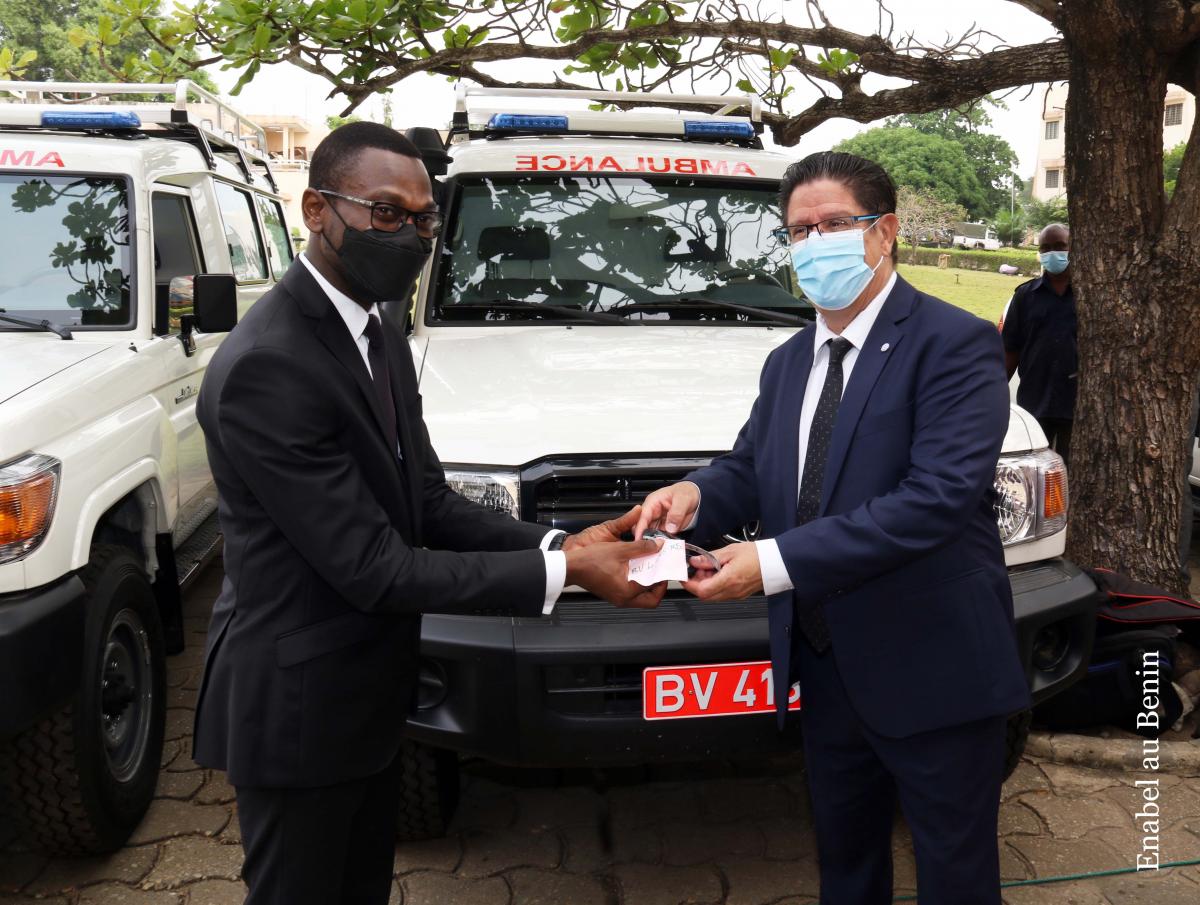Search
Viewing 1995 to 2010 of 3078 news
-
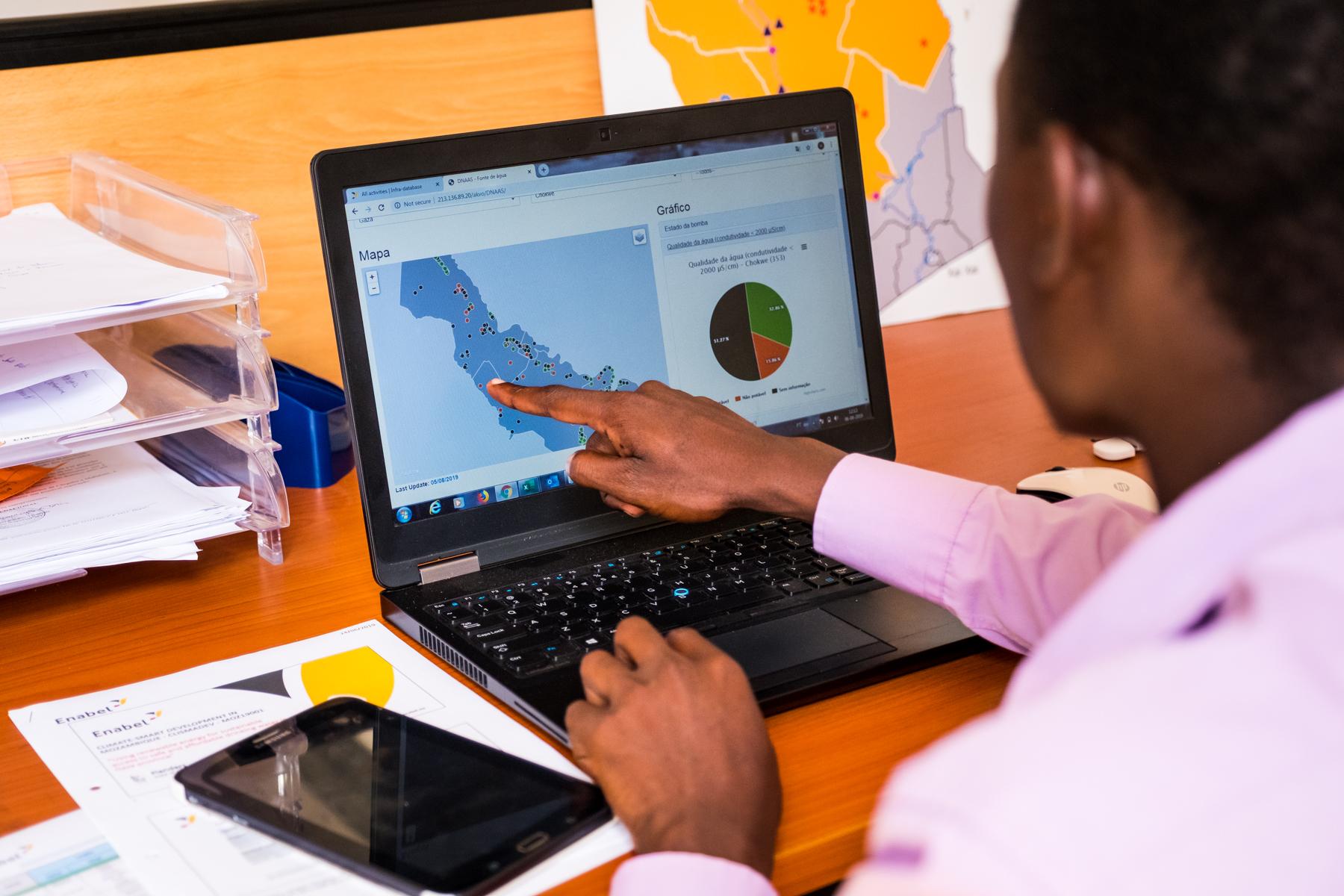
In Mozambique, Enabel’s extension of its Study and Expertise Fund allows to mobilise expertise in the fight against climate change
Akila MUNIR | 21/01/2021
By: Jesse Waterschoot and Akila MunirEnabel’s Study and Expertise Fund in Mozambique is in place since 2014. The aim of this project is to support sectors through studies, consultancies and providing technical expertise in priority areas identified for the cooperation between Belgium and Mozambique. This includes climate change related themes such as (renewable) energy, water management, agriculture, as well as the health sector and gender. With a budget of 750,000 euros, the fund supported consultancies and expertise requests from the line ministries. The results and insights of studies provided by the fund have impacted recent governmental policy changes, such as the strategy for fighting gender-based violence and the water strategy for rural areas. While the fund has continuously received requests, budget constraints limited the number of commitments possible. Due to its relevance and significance in the Enabel portfolio in Mozambique, in December 2020, an addendum to this project was signed with an additional budget of 1,25 million euro and extension up to 2023. This allows the mobilisation of several key studies in Enabel Mozambique’s priority areas going forward. Additionally, part of these funds will be directed to support specialised technical assistance, namely a Climate Finance Advisor from the National Determined Contribution (NDC) Partnership to assist Mozambique to reach its commitment in the Paris 2015 Climate Change agreement.Combatting global carbon emissionEnabel developed strong expertise and institutional partnerships with technical ministries in energy and water projects, closely related to climate change mitigation and adaptation strategies. Mozambique is extremely vulnerable to climate change due to its long-coast line and dependency on the agricultural sector. Consequently, the country suffered under the cyclones and droughts of the past years. Combatting global carbon emission and joining multilateral climate initiatives is therefore crucial for Mozambique.One of the most important recent multilateral initiatives on climate change is the 2015 Paris Agreement, that aims to keep the global average of temperature increase below 2°C. Countries that ratified this agreement committed to limit global warming and support sustainable development initiatives. In light of this, all countries will provide a national strategy to cut their carbon emission in their national determined contributions (NDC). Of course, not all countries have equal access to the expertise and knowledge to reach this goal. To tackle this issue and promote multilateral climate cooperation, the NDC Partnership was founded, which ensures that countries receive assistance to achieve ambitious climate targets. Countries can request support for technical assistance or financial aid to the NDC secretary, that subsequently reaches out to other member states and requests them to assist.Mozambique’s climate ambitionsMozambique submitted an ambitious mitigation commitment plan to reduce 76.5 MtCO²e from 2020 to 2030, and in 2018 it launched a comprehensive partnership plan for climate action that includes 11 sectors. To succeed, the government identified the need for an Economic Planning and Coordination Advisor and a Climate Finance Advisor, so the Ministry of Economy and Finance decided to request assistance for those two experts to the NDC secretariat. While the Economic Planning and Coordination Advisor is being financed by the World Bank, the NDC secretariat reached out to Belgium, a member since June 2017, for funding the second advisor, because of Belgium’s active engagement in climate change across the globe, specifically with an ongoing bilateral cooperation in Mozambique.Due to the noteworthy coordination between the different Belgian actors, including the FPS Public Health, Food Safety and Environment (focal point), FPS Foreign Affairs (focal point), and the Belgian development agency, the necessary support was secured via Enabel Mozambique’s Study and Expertise Fund. Truly a #TeamBelgium approach in actively supporting initiatives for climate action. In this way, Enabel was able to commit the necessary funds for the Climate Finance Advisor and helps contributing to Mozambique’s NDC engagements. The Enabel funded Climate Finance Advisor will work across line ministries and mobilise development partners to identify and develop projects and proposals to access resources from national and international sources to assist Mozambique in achieving its NDC commitments. The addendum of the Study and Expertise Fund will be a useful tool between the Belgo-Mozambican cooperation to continue to contribute to the promotion of expertise and knowledge transfer, national and sector strategy plans and sustainable development goals.
-
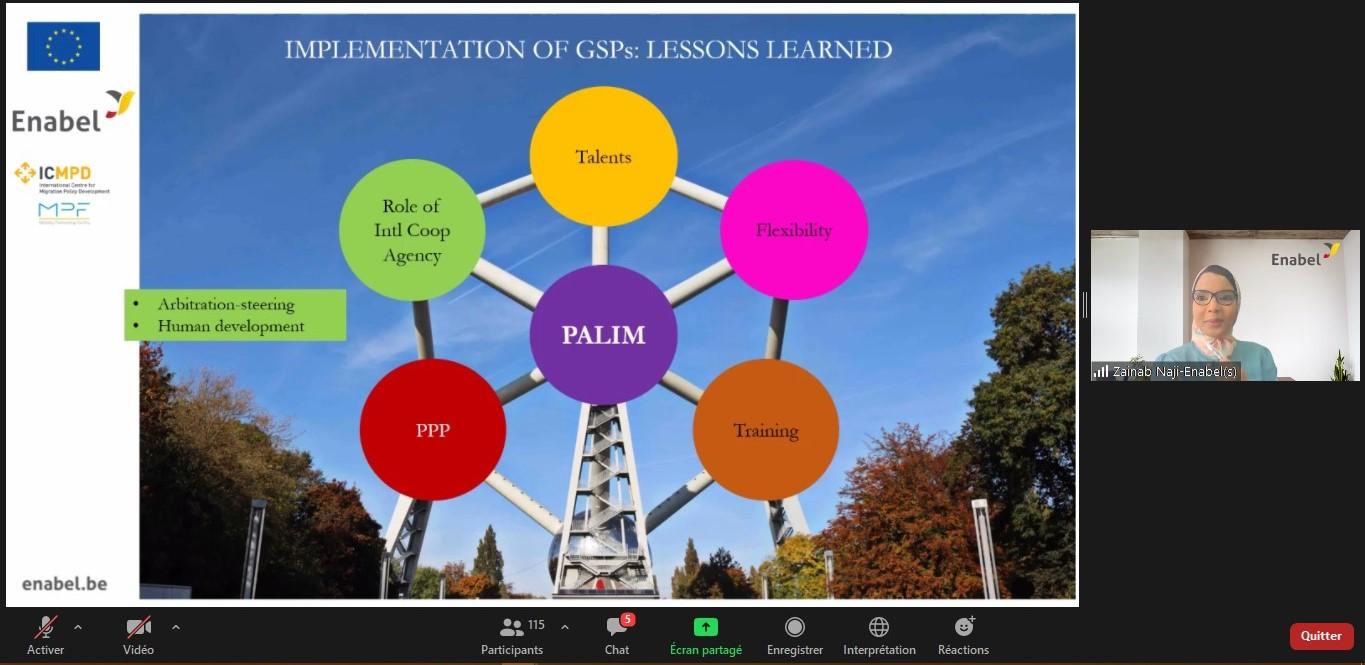
Maroc: Le projet PALIM présenté au "Global Forum on Migration and Development"
Meriem HILALI | 20/01/2021
Lors de La 13éme édition du "Global Forum on Migration and Development", tqui s'est enu du 18 au 26 janvier 2021 à Dubaï, Enabel a exposé cinq principales leçons apprises durant la mise en œuvre du projet PALIM. Enabel met en œuvre les projets PALIM et THAMM suivant le modèle "Global Skills Partnership" ou "Partenariat Mondial des Compétences", qui considère que la mobilité du travail n'est bénéfique pour toutes les parties que si les employés potentiels peuvent trouver un emploi qualifié dans leur pays d'origine et dans le pays de destination.Le PALIM vise essentiellement la formation de talents au Maroc et leur mise à l'emploi, tant au Maroc qu'en Belgique, via un schéma de mobilité concertée. Ces projets s'alignent également sur des objectifs mondiaux importants tels qu'une meilleure gestion des migrations, conformément aux objectifs liés à la migration du Programme des objectifs de développement durable à l'horizon 2030. Ils s'alignent également sur le cadre global de la politique de migration extérieure de l'Union européenne, l'agenda européen en matière de migration et l'approche globale de la migration et de la mobilité.
-
Bénin: Nouvel appui du projet EQUITE en soutien au plan national de riposte contre la Covid-19
Reece-hermine ADANWENON | 19/01/2021
Monsieur Marc VIZY, Ambassadeur de France au Bénin a procédé le mardi 19 janvier 2021 à une remise de matériels roulants, de tests PCR et de kits de prélèvements pour le dépistage de la Covid-19 à Monsieur Benjamin HOUNKPATIN, Ministre de la Santé. Cette cérémonie qui s’est tenue dans l’enceinte du Ministère de la Santé en présence de Monsieur Jérôme BERTRAND-HARDY, Directeur de l’Agence Française de Développement (AFD) au Bénin et de Monsieur Jean-François MICHEL, Représentant Résident d'Enabel au Bénin, réaffirme l’engagement de la France à la mise en œuvre du plan de riposte contre la Covid-19 au Bénin, après une première remise de matériels de réanimation en juillet 2020. D’un montant de 460 069 413 francs CFA, le lot de matériels et équipements acquis via le projet EQUITE mis en œuvre par Enabel au Bénin est composé de :• 5 ambulances pour le département des Collines, • 2 véhicules pour l’Agence Nationale de Transfusion Sanguine (ANTS) du Borgou-Alibori, • 2 véhicules pour l’Agence Nationale de Transfusion Sanguine (ANTS) des Collines,• Et 34 000 tests PCR COVID-19 et 44 000 kits de prélèvement. Ces équipements à destination des différents centres de prise en charge du pays permettront d’améliorer considérablement les soins apportés aux malades hospitalisés, en particulier les cas les plus graves et de renforcer durablement le système de santé du Bénin. Selon M. Marc VIZY, Ambassadeur de France au Bénin, cette deuxième contribution de la France au Plan de riposte du Bénin permettra de renforcer davantage les capacités du Ministère de la Santé en matière de diagnostic/dépistage de l'épidémie du Coronavirus. En effet, à travers le projet Equité (financé par l’Agence Française de Développement (AFD)) dont le budget a été réaménagé au profit de la lutte contre la Covid-19 (une subvention de 11 millions d’Euros pour la lutte contre la pandémie et un financement complémentaire de 2 millions d’Euros), la France appuie le Bénin pour une réponse rapide au plan de riposte portant ainsi sa contribution totale à 3 millions d’euros, soit 2 milliards de FCFA. Pour le Professeur Benjamin Hounkpatin, l’urgence de la réponse à la crise sanitaire engendrée par la Covid-19 est un défi majeur pour tous les systèmes de santé du Monde. « En ce moment difficile, le gouvernement et le peuple béninois ont ressenti la solidarité et la proximité du gouvernement français à travers divers appuis pour soutenir les actions de riposte engagées dans notre pays. Nous avons apprécié que l’Agence Française de Développement ait accepté d’apporter cette réponse rapide au Plan de riposte du Bénin à travers une adaptation du budget du projet EQUITE dont une part a été réorientée à la lutte contre la pandémie de Coronavirus » a, t-il ajouté. Il a ensuite salué le rôle stratégique important joué par Enabel dans la mise en œuvre du Projet Equité et qui a permis d’acquérir dans des délais relativement courts le lot d’équipements. A l’en croire, ce matériel contribuera sans nul doute à améliorer de manière substantielle, les capacités de diagnostic du personnel soignant en ce moment de recrudescence des cas au Bénin ainsi que le transfert et le traitement des patients atteints de la Covid 19. L’appui en ambulance et en moyens roulants pour les Centres de transfusion sanguine renforcera davantage le système de santé du Bénin et la capacité à relever le défi du Bénin en matière de prise en charge des autres maladies, dira-t-il. A ce propos, Dr Benjamin Hounkpatin a exprimé la reconnaissance du gouvernement du Bénin à Enabel, à l’Agence Française de Développement, ainsi qu’à l’équipe du projet EQUITE pour les efforts fournis. « Les Directeurs Départementaux de la Santé « DDS » seront instruits pour un usage rationnel des véhicules et ambulances », a-t-il promis.
-

Soutien à l’Etat civil dans le Centre et le Nord du Mali
Nènè TRAORE | 19/01/2021
Compte tenu du contexte politico-sécuritaire du pays fragilisé et particulièrement dans les zones du Centre et du Nord du Mali, le projet PAECSIS travaille, à travers des conventions de subsides, avec deux ONG ayant une bonne connaissance de ces territoires, ASSOPROFEN et Human Help.Ces ONG ont une grande maîtrise du terrain et ont un accès plus facile aux communes ciblées dans ces régions (Mopti, Gao, Ménaka, Kidal et Tombouctou). Les ONG ASSOPROFEN et Human Help sont chargées d’appuyer 21 communes dans l’élaboration de leurs plans d’amélioration des "ervices de l’état civil (PASEC).Par ailleurs, ces structures ont pour rôle d’assurer la coordination et la supervision des activités de sensibilisation des populations à l’état civil en étroite collaboration avec les acteurs de l’état civil au sein de la commune (Préfet, Maire chargé de l’état civil, Secrétaire Général, agents d’état civil, agents de déclaration sanitaires et villageois etc.).
-

Mali: Le e-learning pour renforcer les compétences des acteurs de l'Etat civil
Nènè TRAORE | 19/01/2021
Dans le cadre de la Stratégie Nationale de Formation des Acteurs de l’Etat Civil (SNFAEC), validée fin novembre 2018, le PAECSIS a appuyé la Direction Nationale de l’Etat Civil à définir l’architecture, les contenus et les supports pédagogiques des Parcours d’Acquisition et Développement des Compétences (PADC) pour huit (8) des onze (11) métiers répertoriés dans le référentiel des métiers de l’état civil.Le PAECSIS a, sous le pilotage de la Direction Nationale de l'Etat Civil, mobilisé, fin 2020, une mission d’expertise pour étudier la faisabilité de la mise en place d’une formation à distance déclinant les parcours d’acquisition et de développement des compétences (tronc commun et modules spécifiques). A terme, la mise en place d’un dispositif de formation e-learning viserait à améliorer l’offre de service de l’état civil via le renforcement des compétences des acteurs de l’état civil, notamment au niveau des Ambassades et Consulats.
-
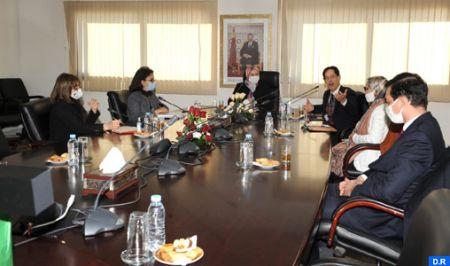
L'impact positif du projet "Maghrib Belgium Impulse" au Maroc
Meriem HILALI | 18/01/2021
La mise en œuvre de la stratégie nationale en faveur des MRE (Marocains résidants à l'étranger) était au centre d'une réunion entre le Ministère Délégué Chargé des MRE et des Affaires de la Migration et la Confédération Générale des Entreprises du Maroc (CGEM). Pour en savoir plus, lisez l'article de presse qui en parle: https://www.mapnews.ma/fr/actualites/economie/la-mise-en-%C5%93uvre-de-la-strat%C3%A9gie-nationale-e...
-

Le Port autonome de Cotonou se modernise avec l’accompagnement d’Enabel et du Port d’Anvers
Reece-hermine ADANWENON | 15/01/2021
Démarré depuis juin 2019, le projet d’appui au secteur portuaire (PASPort) ambitionne d’améliorer la compétitivité du secteur portuaire au Bénin. Après une année de mise en œuvre, que retenir des actions menées dans le cadre de cet appui d'Enabel? Pascaline ADJOFOGUE est originaire du Bénin. Elle a 25 ans et est aujourd’hui la première femme Capitaine des remorqueurs au Port Autonome de Cotonou. Elle a bénéficié d’une formation au Port d’Anvers dans l’équipage du Bénin grâce au partenariat Bénino-Belge. « Lorsque j’ai commencé ma fonction en tant que capitaine de remorqueurs, je manœuvrais seulement avec les remorqueurs classiques. Je rêvais vraiment de manœuvrer les remorqueurs de type ASD (Remorquer Azimutal Stern Drive - capable de manœuvrer dans tous les sens). Par le biais d'Enabel au Bénin, j’ai eu cette opportunité et je suis partie à Anvers pour suivre cette formation. Je suis de retour dans mon pays pour manœuvrer désormais ces remorqueurs. Avec ce renforcement de capacité, je serais encore plus utile au Port Autonome de Cotonou dans l’atteinte de ses objectifs. Dans la sous-région, aujourd’hui je suis la seule femme qui manœuvre les remorqueurs de type ASD et j’en suis vraiment fière », nous dit-elle. La formation des pilotes et des équipages de remorqueurs est le premier domaine d’investissement en formation soutenue par Enabel depuis 2019. Il se poursuit encore en 2020 et au-delà. A ce jour, la Belgique a déjà investi plus de 800.000 euros dans ce programme. Ce programme ciblait au départ un total de 35 agents dont 10 pilotes, 10 capitaines de remorqueurs et 15 matelots, et à ce jour 31 agents en ont déjà bénéficié. « Mon âge et mon genre ne comptent plus. Ce sont mes compétences, mon savoir-faire et mon autorité en tant que cheffe d’équipe qui comptent. J’ai aujourd’hui la responsabilité de mon équipage et du remorqueur, donc je ne tolère aucune largesse. C’est un métier éprouvant physiquement et psychologiquement. Le plus délicat pour moi est d’exercer mon autorité sur les membres de l’équipage sans les frustrer », déclare Pascaline.Le premier succès évident de ce programme de formation est la réussite des 5 tests d’accostage des navires de 300 m en juillet et août dernier ; ce qui est une première au Bénin. Aussi, l’autre réussite fondamentale de ce programme, est que l’ensemble des procédures d’amarrage entre les remorqueurs et les navires, la collaboration entre les pilotes et les capitaines de remorqueurs ont été révisés et améliorés pour augmenter la sécurité de la manœuvre et son efficacité. Désormais les navires pivotent à l’entrée dans le cercle d’évitage, et donc peuvent repartir la proue en avant contrairement à ce qui se faisait auparavant. La révision des procédures et la réorganisation de la Capitainerie est le second programme de formation dans lequel Enabel s’est investi à travers son projet PAORC tout d’abord en 2019 puis son projet PASPort ensuite. Pas moins de 132.000 euros ont déjà été investis dans cet effort qui recouvre aussi bien le planning des mouvements de navires, le suivi de l’exécution de ces mouvements que l’analyse et le rapportage sur les incidents. Par ailleurs, le PAC est désormais certifié International Ship and Port Facility Security (ISPS) « Code international pour la sûreté des navires et des installations portuaires » avec pour impact direct le respect des règles et normes concernant les installations portuaires, le contrôle des entrées et sorties dans un port. Afin de maintenir ladite certification, le PASPort a accompagné le PAC dans l’élaboration et l’appropriation d’un manuel de sûreté dès l’année 2019. Pour 2021, il est attendu le démarrage effectif des activités sur les résultats n°1 intitulé « l’environnement des affaires portuaires et la confiance des opérateurs sont améliorés » et résultat n°3 intitulé « la performance du Port Autonome de Cotonou est renforcée » du projet et un engagement de 100 % du budget dédié au PAC.Il sera également procédé à une évaluation des actions entreprises sur le résultat n°2 intitulé « la mise en œuvre de la problématique environnementale du secteur portuaire est améliorée » afin de mesurer les premiers impacts au niveau du Port de Cotonou.
-
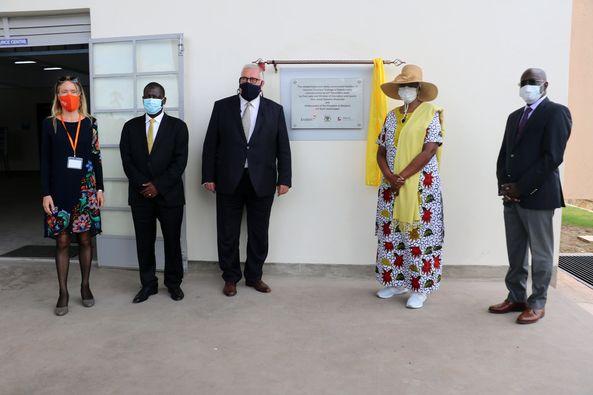
In Uganda, National Teachers’ Colleges receive newly constructed buildings
Dorothy KYAMAZIMA | 07/01/2021
National Teachers’ Colleges operate among the government aided tertiary institutions mandated to train quality teachers for the lower secondary and primary schools in Uganda. Over the years, Enabel has collaborated with the Ministry of Education to improve secondary teacher education by focusing on institutional, infrastructure, and pedagogical aspects of these colleges. In December 2018, the Government of Uganda together with Enabel set aside a total of 12m euros (approximately shs. 50b) to rehabilitate and construct the infrastructure in the National Teachers’ Colleges across the country. The construction works were geared towards improving the College facilities and providing enhanced classrooms, resource centers and laboratories for both students and teachers that are well equipped to suit the needs of teaching and learning in the 21st century. Two years later, Enabel is ready to handover newly constructed and rehabilitated buildings to the five National Teachers’ Colleges of Muni, Mubende, Kaliro, Kabale, and Unyama. During the inauguration ceremony that was held in November 2020 at National Teachers’ College Kabale, the First Lady and Minister of Education and Sports, Hon. Janet Kataaha Museveni alongside the Ambassador of the Kingdom of Belgium, Rudi Veestraeten officially commissioned all the buildings. These included sports facilities, accommodation facilities, dispensary blocks, administration blocks, laboratories, resource centers, classrooms and innovations that focus on creating safe learning environments based on the different needs of the College staff and students such as water systems, walkways, and Early Childhood Development (ECD) centers for new parents in the Colleges.Enabel, through the infrastructure component of the Teacher Training Education (TTE) project, has put a lot of emphasis on creating a healthy functional learning environment that enhances the teaching and learning process. This includes: The architectural designs and infrastructural set-up that take into account several important factors that focus on innovation, sustainability, energy efficiency and the natural environment. Classrooms that benefit from sufficient natural daylight and a well-designed cross ventilation setting off the higher tropical temperatures without any artificial intervention. Developments that create a spacious and flexible learning environment for example classrooms with electricity sockets installed in the center to ease projector and computer use and writing boards and furniture that is easily repositioned. Creation of outdoor learning spaces that give room and resources to both teachers and students to explore different learning techniques and encourage creativity. During the inauguration ceremony, the National Teachers’ College Kabale honored the late head of the infrastructure unit of Enabel, Jan Van Lint by renaming its resource center after him. It now stands as the ‘Jan Van Lint Resource Centre’ in memory of his efforts in championing climate-smart architecture in East Africa and in all the Teachers’ Colleges in Uganda. Enabel has for nearly 10 years supported the improvement of quality of teacher education through infrastructure development and other initiatives. The fully commissioned buildings will benefit over 7,235 teachers and students in all the 5 National Teachers’ Colleges across the country.
-
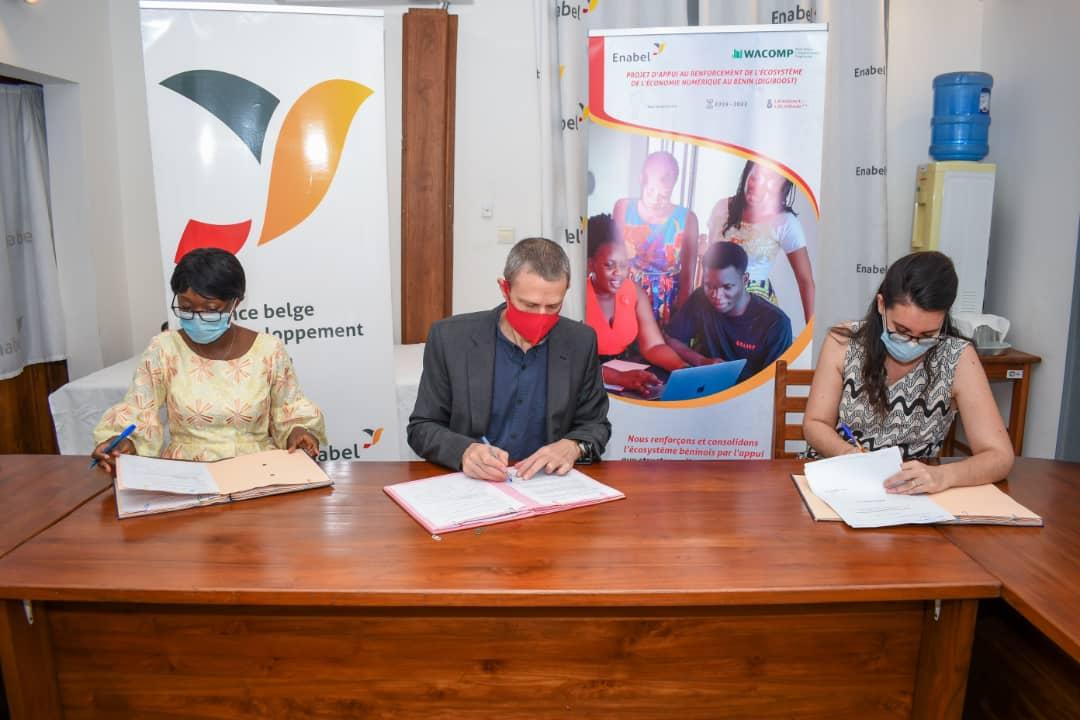
Enabel et Afric’Innov collaborent pour améliorer la gestion des structures d’accompagnement à l’entrepreneuriat innovant
Reece-hermine ADANWENON | 04/01/2021
Pour garantir la performance des entrepreneur.e.s dans le numérique au Bénin, Enabel a pris le pari de renforcer les capacités et performances des structures qui les accompagnement (SAEI) dans le cadre de la mise en œuvre du projet DigiBoost, financé par l’Union Européenne.Afin d’y parvenir certains partenariats clé sont noués avec des acteurs clé des écosystèmes de l’économie numérique en Afrique de l’ouest, dont celui avec Afric’Innov. L’association Afric’Innov regroupe un consortium de structures d’accompagnement à l’entrepreneuriat innovant (SAEI) africaines, son objectif est de professionnaliser ces dites structures par le renforcement des capacités et la mise en réseau. Dans le cadre du projet DigiBoost, Afric’Innov sera en charge de l’amélioration de la gestion et de la durabilité des SAEI béninoises. Pour marquer le lancement de cette collaboration, une convention de subsides a été signée le jeudi 17 décembre 2020 à Cotonou entre le Représentant Résident d’Enabel au Bénin, Jean-François Michel, la Responsable d’intervention du projet DigiBoost, Emmanuelle Bouiti, et la Représentante du Comité d’Administration, Lisa Tietiembou Barutel. Le début de cette belle collaboration est prévu pour janvier 2021 et s’étendra jusqu’en juin 2021.Elle se fera également avec une forte implication des SAEI béninoises qui se trouvent sur tout le territoire.Au terme d’une collaboration entre Afric’Innov et l’équipe du projet DigiBoost, une communauté de SAEI avec un label 100% made in Bénin sera créée, les compétences de gestion des équipes en charge des SAEI seront renforcées, un outil de bonne gestion des SAEI sera mis à leur disposition, et les SAEI auront un Business Model viable. A travers ce partenariat, Enabel souhaite renforcer les capacités professionnelles et organisationnelles d’un acteur clé de l’écosystème de l’économie numérique dans le cadre de sa collaboration avec le Ministère du Numérique et de la Digitalisation pour accélérer la croissance économique dans le cadre du Programme d’Action Gouvernementale (2016-2021).
-
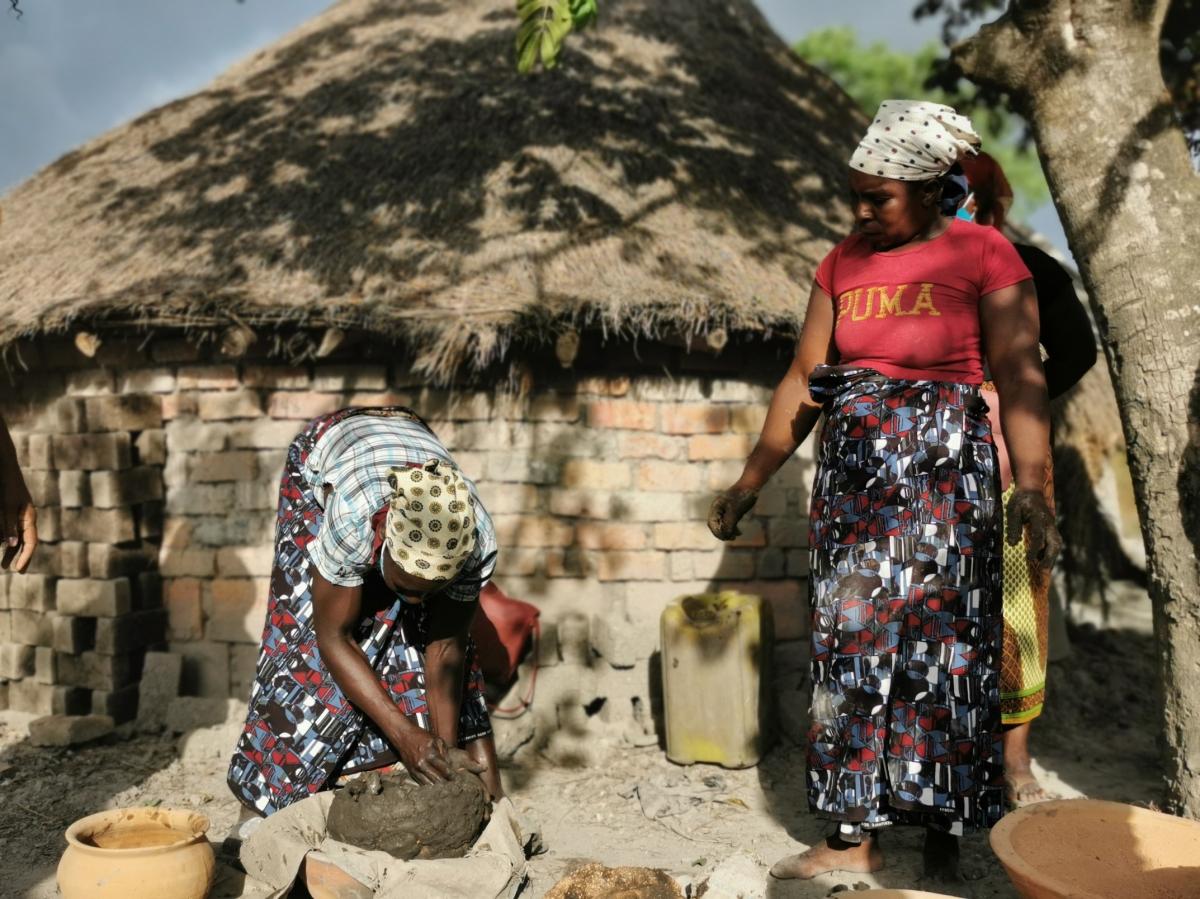
The role of alternative sources to achieve sustainable access to energy for all in Mozambique
Akila MUNIR | 24/12/2020
By: Evert Waeterloos and Akila Munir Around 2.7 billion people around the world still utilise traditional cookstoves with solid fuels such as firewood, coal and dung for daily cooking and heating. Women and girls play a pivotal role for energy provision in households, including collecting traditional fuels, which constrains them from pursuing other social or economic generating activities. Since they are also responsible for cooking the meals, they are disproportionately affected by the health impacts of indoor air pollution and risks associated with solid fuel collection (UNIDO/UNWomen 2013; World Bank 2018). “Before buying the improved cooking stove, every time I cooked, my home would be filled with smoke and my eyes would burn” – Maria from the district of Chonguene, Gaza Province, Mozambique Adopting the shift to clean, efficient cooking practices can reduce air pollution, improve people’s health, but also mitigate the environmental impact and increase social and economic productivity. However, changing cooking practices in households is not always easy, as it involves raising awareness of the associated benefits of adopting improved cookstoves and cleaner fuels, changed behaviour and access to affordable products. Within the renewable energy portfolio, Enabel in Mozambique is working with the Ministry of Mineral Resources and Energy in capacity building of gender mainstreaming in the renewable energy sector. Enabel has held various seminars and workshops in the past years to address the gender dimensions of the UN’s 2030 objective of sustainable access to energy for all. The most recent seminar was held from the 15th to the 18th of December 2020, and focused on the role of solar home systems, clean cooking stoves and biomass fuels. Twenty gender focal points from the central and provincial directorates gathered together in Xai Xai, Gaza Province from the 15th to the 18th of December 2020o to debate on the role of gender in the energy sector, government’s objective to facilitate sustainable access to energy for all (including the majority of the population that live in very remote areas), and clean and accessible energy alternatives for rural communities outside the grid. The seminar was designed to be participative and immersive, and zoomed in on the promotion and training of women in business management and sustainable energy technology, such as solar home systems (SHS), locally produced and marketed improved cooking stoves, and bio-briquettes. The focal points visited for instance the village of Macupulene in Chonguene district, which hosts a cooperative that produces, sells and transports improved cooking stoves. Women of the community play a significant role in making and selling the clay-based improved cooking stoves. They not only produce, but also act as entrepreneurs and activists which, through the cooperative, are successfully raising awareness of the benefits of improved cooking stoves in countering the unsustainable harvesting and use of firewood and charcoal in the district. Including women as part of this supply chain and generating an income, helps them move out of poverty while simultaneously implementing a multi-level awareness campaign. Alberta, a mother of 4 that lives in Chonguene, said “I now spend less time cooking meals for my family and I can see my children more during the day”. Likewise, Mama Lucinda, one of the women entrepreneurs and activists from the cooperative said “Not only does my husband support me as I contribute to the house, but I feel like the community supports me as we bring these stoves to their homes.” The community visits and interactions with the entrepreneurs were one of the several participative activities of the seminar. At the end of the seminar, the gender focal points felt that they now have greater understanding of the concept of access to energy for all, and the empowering effect locally produced alternative technologies can have. They also elaborated a draft Action Plan to be shared with the Ministry of Mineral Resources and Energy for gender mainstreaming in the renewable energy sector. Enabel has committed itself to support such gender mainstreaming activities in the coming 2 years.
-

Maroc - La première édition de l’école intensive sur le droit d’asile et de la migration : la digitalisation au service de l’accès aux droits des étra
Bilal ALJOUHARI | 18/12/2020
Le 27 novembre 2020 s’est conclue la première édition de l’école intensive sur le droit d’asile et de la migration. Durant cinq jours, 57 participants ont échangé sur le droit d’asile et de la migration avec des professeurs, chercheurs, représentants d’institutions publiques marocaines et internationales et associations travaillant sur la thématique de la migration.La première édition de l’école intensive sur le droit d’asile et de la migration a été organisée, du 23 au 27 novembre 2020, par l’Université Mohammed 1er d’Oujda et Enabel, en collaboration avec l’Université catholique de Louvain (UCLouvain - Belgique) et Jean-François Durieux, expert international. Durant ces cinq journées de cours, 57 participants – des étudiants en droits travaillant au sein de cliniques juridiques, des membres d’associations travaillant sur la migration et d’associations communautaires – ont participé à des sessions portant sur différents aspects du droit d’asile et de la migration. L’objectif principal de l’école était de donner aux participants des informations relatives aux contextes international et national de différents axes du droit applicables aux étrangers au Maroc. Les différentes thématiques du droit des étrangers au Maroc ont été traitées par des experts marocains et internationaux issus d’universités, d’institutions publiques, d’organisations internationales et de la société civile. Les sessions ont également bénéficié de l’expérience de migrants et de l’expertise d’associations travaillant sur la thématique migratoire. Ces échanges entre participants et intervenants ont permis de confronter la théorie du droit à sa pratique, renforçant ainsi l’apprentissage de tous. Grâce à leurs profils variés et leurs riches expériences, les participants et intervenants ont contribué à une meilleure analyse de la dimension intersectorielle de la migration et des droits des étrangers. . L’école intensive était organisée dans le cadre de l’intervention « Empowerment juridique des personnes migrantes », financée par l’Union européenne via le Fonds fiduciaire d’urgence, et mise en œuvre par Enabel, en partenariat avec le Ministère de la justice et le Ministère délégué auprès du Ministère des Affaires étrangères, de la Coopération africaine et des Marocains résidant à l’étranger, chargé des Marocains résidant à l’étranger. L’intervention apporte notamment un appui à quatre cliniques juridiques rattachées respectivement à l’Université Hassan II de Casablanca/ Aïn Chok, à l’Université Mohamed Ie d’Oujda, à l’Université Mohamed V de Rabat/ Agdal et à l’Université Abdelmalek Saâdi de Tanger. Ces cliniques juridiques sont des espaces au sein desquels des étudiants en droit travaillent sur des cas réels et des questions sociales, sous la supervision d’enseignants-chercheurs et de professionnels du droit. L’école intensive sur le droit de la migration et de l’asile vient compléter des ateliers et séminaires thématiques qui sont organisés afin de renforcer les connaissances des étudiants impliqués dans les cliniques juridiques en matière de droit d’asile et de la migration. Étant donné les circonstances sanitaires actuelles, l’école intensive a été organisée sur cinq pôles, à savoir les villes de Rabat, Casablanca, Oujda, Tanger. Des intervenants, tels que l’UCLouvain et Jean-François Durieux intervenaient également à distance. Au sein de chaque pôle, les participants ont pu avancer ensemble dans leur apprentissage pratique du droit des étrangers, à travers des cours, mais également d’exercices de groupe. L’école intensive a mis en lumière la nécessité de continuer à renforcer le dialogue entre les différents acteurs du droit. Les échanges entre les différents praticiens (institutions publiques, organisations internationales, universités, avocats, associations) ont contribué à renforcer l’analyse du droit, le partage de bonnes pratiques et l’élaboration de recommandations permettant de renforcer l’accès aux droits. Ce travail en réseau et cette coordination nécessaires entre les différents intervenants du droit des étrangers sont au cœur de l’intervention « Empowerment juridique des personnes migrantes ».
-
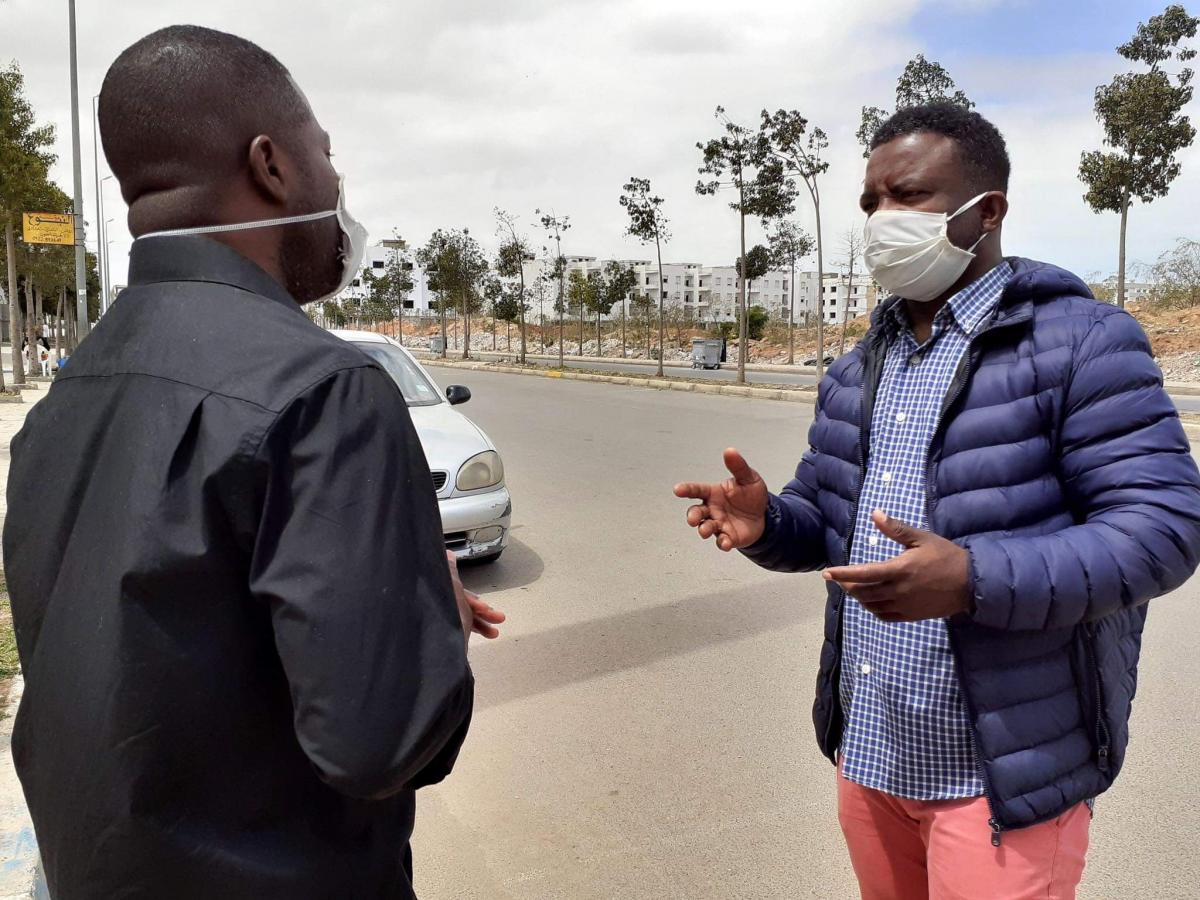
Amuddu célèbre le Journée Internationale des migrant·es - Maroc
Clara HUYGHE | 18/12/2020
Cette année, le projet Amuddu célèbre la Journée Internationale des migrant·es dans un contexte de pandémie, suscitant du projet une réponse agile et urgente. De nouvelles actions ont été mises en œuvre pour appuyer les migrant.es et réfugié.es en situation de vulnérabilité au Maroc. Bon nombre d’entre eux et d’entre elles vivent dans des conditions économiques difficiles accentuées par l’arrivée du virus Covid19. Dans ce sens, l’intervention a appuyé ses partenaires notamment l’institution marocaine d’assistance sociale notamment Entraide Nationale dans sa réponse aux besoins des populations fragiles face à la crise sanitaire.Cet appui a permis à l’Entraide Nationale de répondre efficacement à des situations d’urgences au niveau des régions de Rabat et de Casablanca. Sachant que les migrant·es sont les plus exposé·es à la perte de leurs moyens de subsistance, ce soutien ainsi que le travail en matière de sensibilisation,d’information et d’orientation ont contribué à la diminution des effets négatifs de cette situation de crise. En outre pour l’année 2020, Amuddu a également accompagnées les efforts de l’Agence Nationale pour la Promotion de l’Emploi et des compétences ANAPEC à assurer ses services d’accompagnement à l’emploi et l’auto-emploi à distance, à plus de 291 personnes. De plus, 9 coopératives ont récemment été créées.Finalement, Amuddu a concrétisé des partenariats avec différentes organisations de la société civile, à savoir REMESS, CAREMaroc et AMAPPE, pour renforcer l’employabilité des personnes migrantes au marché de l’emploi et de l’auto-emploi.Toutes les activités réalisées se sont concrétisées en partenariat avec le Ministère délégué auprès des Affaires Étrangères, de la Coopération Africaine et des Marocains Résidant à l'Étranger, Chargé des Marocains Résidant à l’Etranger, l'Entraide Nationale et l’Agence nationale de promotion de l'emploi et des compétences.
-
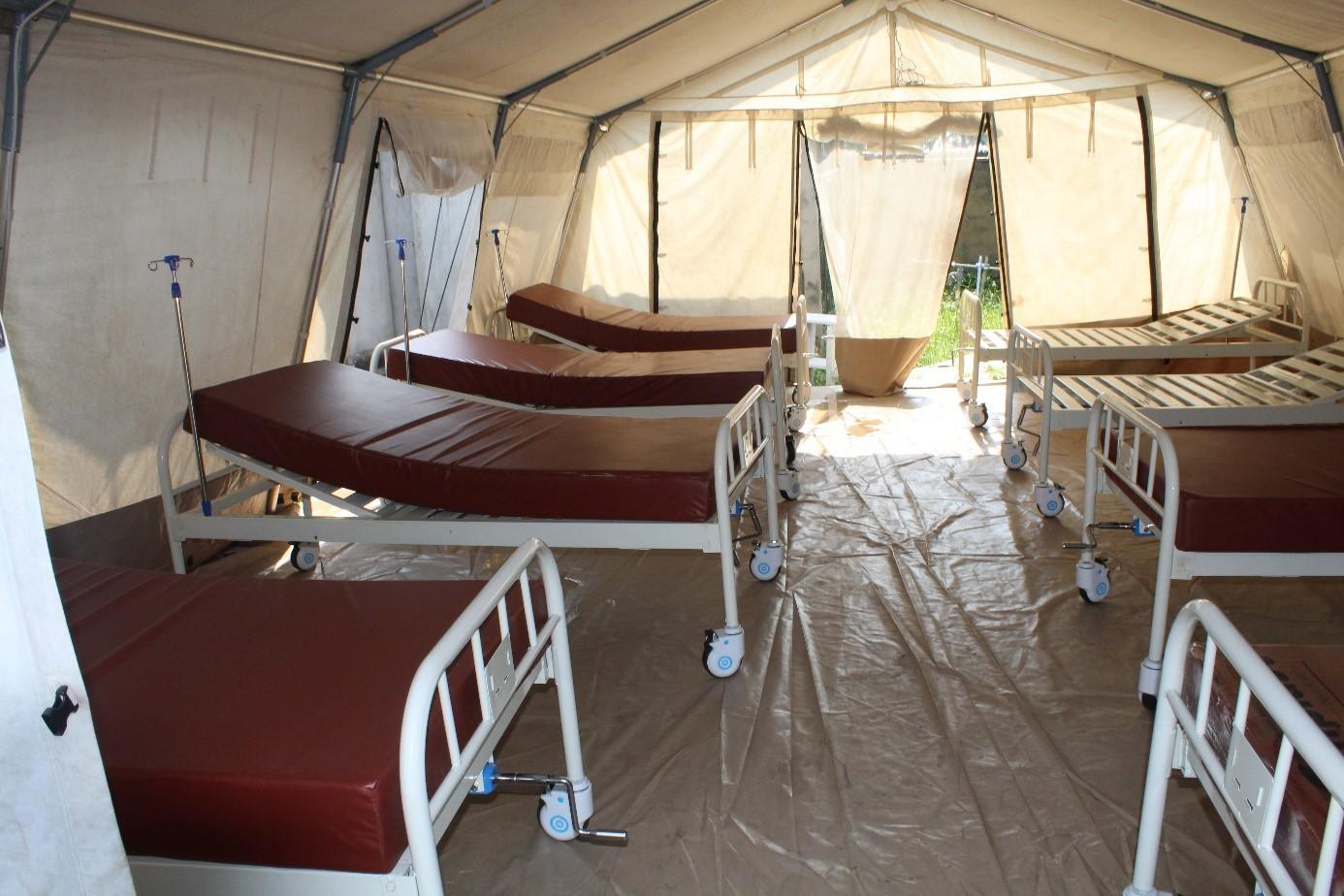
RDC: Actions urgentes face à la recrudescence de cas Covid-19 à l’Hôpital Général Saint Joseph
Grâce MALI FAIDA | 17/12/2020
Il est observé depuis mi-novembre 2020, une hausse de nouveaux cas de Covid-19 en RDC et dans la ville province de Kinshasa, en particulier. L’Hôpital Général de Référence Saint Joseph (HGRSJ) abrite l’un des centres de traitement et de prise en charge de Covid-19 (CTCo) de la capitale. Il bénéficie de l’appui du programme Covid-19 Saint Joseph, mis en œuvre par Enabel avec l’appui financier de l’Union Européenne. En plus des actions déjà en cours, en l’occurrence, la prise en charge totale des soins des patients suivis en ambulatoire et de ceux en hospitalisation ainsi que la prise en charge nutritionnelle des patients admis en hospitalisation au CTCo ; le programme Saint Joseph Covid- 19 a, face à la flambée actuelle des cas, appuyé le CTCo de l’HGRSJ dans le renforcement de ses capacités dans les actions de prévention et de prise en charge pour une réponse adaptée et de qualité : − Au niveau de la prévention : la sensibilisation a été renforcée au sein de l’HGRSJ au profit des patients et leurs accompagnants dans l’objectif de les informer sur les mesures de prévention, y compris les gestes barrières et le port correct des masques ; la distribution des masques en tissus et lavables à tout arrivant à l’HGSRSJ ; l’acquisition d’un nouveau portique pour la désinfection des vêtements, des matériels et des accessoires de tout arrivant à l’hôpital (personnel, patients et accompagnants) ainsi que la dotation en équipements de protection individuels (EPI) et produits de désinfection qui sera suivie par la remise des matériels et équipements d’hygiène dans les prochains jours ; − Au niveau de la prise en charge des patients, Enabel a renforcé le CTCo avec un premier lot de concentrateurs d’oxygène, le deuxième lot étant en cours d’acquisition. Dans le souci d’augmenter les capacités de réponse du CTCo face au nombre grandissant des patients en hospitalisation, le programme Covid-19 a acquis 40 lits et 20 matelas supplémentaires en vue d’être montés dans les tentes de 6,25 m × 7,80 m qui sont en cours d’aménagement. Ces tentes ont été rendues disponible avec le concours de MSF-France. Ces dispositifs permettront d’augmenter la capacité d'accueil du CTCo à l'HGRSJ.
-
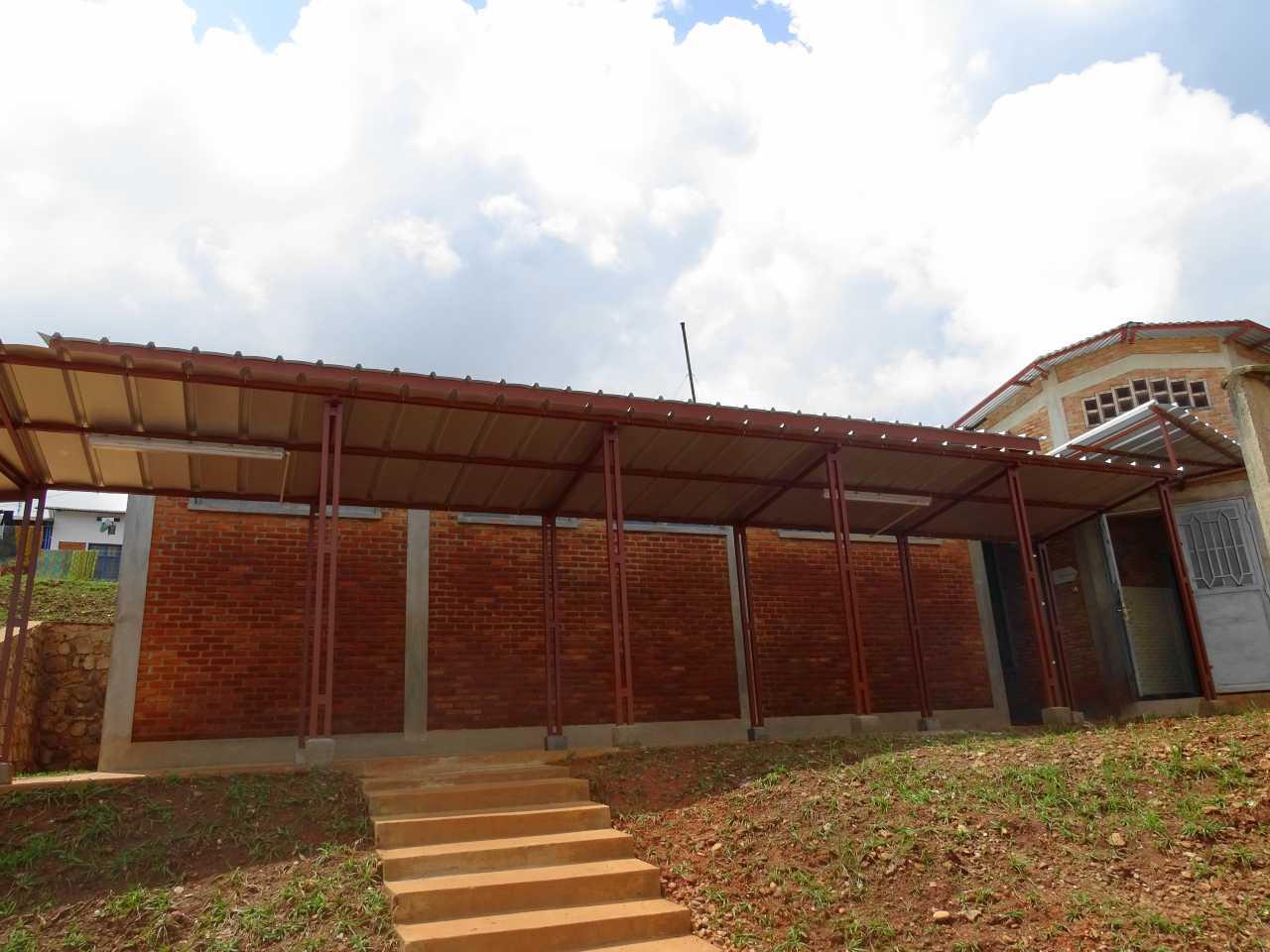
Maintenance des équipements biomédicaux ou l’enjeu de la pérennité - Burundi
Carla MORVAN | 15/12/2020
La maintenance d’équipements biomédicaux et de laboratoire permet de maximiser la valeur des ressources en technologies de la santé. Dans le cadre du projet Twiteho Amagara, financé par l’Union européenne, le consortium Enabel appuie la maintenance de ces équipements. L’ensemble des activités d’appui à la maintenance se fait en collaboration étroite avec le Ministère de la Santé Publique et de la Lutte contre le Sida (MLPLS) au travers de la Direction des Infrastructures Sanitaires et des Equipements (DISE). Les missions menées dans le cadre de cette activité sont de trois types. Premièrement, un inventaire exhaustif des équipements existants est établi et mis régulièrement à jour à la suite de nouvelles acquisitions, de panne ou de déclassement de quelque équipement que ce soit. Cette mise à jour se fait à travers une application de Gestion de la Maintenance Assistée par Ordinateur (GMAO). La GMAO sert également à planifier les 2 autres types de maintenance. Ensuite il y a des missions de maintenance préventive, dont l’objectif premier est de prolonger la durée de vie des équipements biomédicaux et de laboratoire et d’éviter les défaillances. Il s’agit d’encadrer les techniciens de maintenance placés dans les districts sanitaires pour suivre un calendrier pré établi de visites dans les différentes formations sanitaires (FOSA) en vue de l’entretien périodique des équipements consistant en général à une revue des listes de contrôle et entretiens non complexes. Le troisième type de mission qui s’effectue dans le cadre de cette activité correspond aux maintenances curatives. Ces missions ont lieu lorsqu’une panne s’observe. Nous pouvons prendre pour exemple le cas récent de panne d’un appareil de radiographie de l’hôpital de district de Mukenke (province de Kirundo), pour lequel Enabel, accompagné d’un ingénieur de la DISE a du se déplacer afin d’évaluer le problème et d’y remédier. Il existe des cas où les techniciens de maintenance ne peuvent pas intervenir soit parce que le diagnostic des pannes est difficile à poser pour cause de connaissances limitées, de boîte d’outils limitée, ou encore parce que les pièces de rechange ne sont pas accessibles. Dans ce cas il est fait appel à des prestataires externes. Cette externalisation de la maintenance présente un double objectif. Il s’agit en premier lieu de réparer du matériel défaillant et assurer la pérennité du fonctionnement de la FOSA en question. Mais cela va plus loin que ça. Les prestataires externes sont recruté-e-s pour une période déterminée. Période durant laquelle ils et elles seront suivi-e-s dans leurs missions par les techniciens et techniciennes des FOSA. Le but final étant de former ces dernier-e-s afin qu’à la fin du contrat des prestataires externes, ils et elles puissent prendre le relais, monter en compétence et assurer la maintenance des équipements plus sophistiqués.La maintenance des équipements biomédicaux et de laboratoire est également centrale dans une logique de protection de l’environnement. En effet, la logique derrière la maintenance est la pérennité du matériel. Si la maintenance est faite correctement, nous observerons moins de cas de pannes, ce qui signifie, in fine, moins de nécessité de renouvellement du matériel. La fabrication du matériel médical étant synonyme d’empreinte carbone élevée, moins celle-ci est élevée, meilleur est l’impact sur la protection de l’environnement et sur la consommation des ressources de la terre. L’aspect économique de cette maintenance est également à prendre en considération. En effet, des économies non négligeables sont à envisager dans le cas d’une maintenance efficace de ces équipements car généralement, les équipements biomédicaux et de laboratoire sont onéreux.
-

Insertion professionnelle de jeunes stagiaires dans la Tshopo en RDC
Grâce MALI FAIDA | 11/12/2020
Le programme EDUT soutient l’offre d’une formation professionnelle de qualité et à la création d’emplois décents pour les jeunes dans la Tshopo.Son ambition est d’augmenter significativement le nombre de jeunes insérés (2500 entrepreneurs et emplois-salariés dont 50% de jeunes filles) et ainsi passer d’une approche employabilité vers celle d’emplois effectifs. Le partenariat avec le secteur privé, par l’entremise de la FEC (Fédération des Entreprises du Congo) - Direction provinciale de la Tshopo, s’est concrétisé par une opportunité d’insertion professionnelle de 34 jeunes issus de 8 filières de formation diverses à la SCIPEC (Société de Culture Industrielle, Pêche et Elevage du Congo). Ces jeunes ont pu renforcer leurs compétences et savoir-faire sur plusieurs sites : de la palmeraie en passant par le poulailler, l’atelier de menuiserie pour chuter sur l’installation et le montage de A à Z d’une unité mobile de transformation d’huile de Palme (https://www.rentec.be/fr/palm-oil-extraction-machines/rural/rural) conçue en Belgique. Ce fût une véritable innovation dans la Tshopo tant son installation a mobilisé à la fois des maçons, des mécaniciens, des électriciens et des agronomes.
